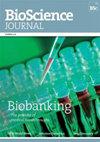In vitro establishment and multiplication of Echynochloa polystachya
IF 0.6
4区 农林科学
Q3 AGRICULTURE, MULTIDISCIPLINARY
引用次数: 0
Abstract
The objective of this work was to carry out the in vitro establishment of Echynochloa polystachya aiming at obtaining a micropropagation protocol for works involving the selection of superior genotypes and the cultivation of the species. E. polystachya stems were collected in the municipality of Manaus-AM. Explants were inoculated in test tubes containing Murashige and Skoog (MS) medium. Thirty days after in vitro establishment, the rate of sprouting and contamination were evaluated. Experiments were also carried out to assess the effects of sucrose and 6-benzylaminopurine (BAP) concentrations on the tillering rate of explants. It was found that during the successive subcultures there was a decrease in internodes and the consequent loss of vigor. There were responses in the multiplication rate at concentrations starting from 45 g L-1 sucrose. In addition, BAP and sucrose interfered the development and in vitro multiplication. Sucrose in conjunction with BAP was harmful and shortened internodes. The physiological state of the explants for the species under study was intrinsically linked to the concentrations of sucrose used for the culture medium and the concentrations of BAP. However, the sucrose and BAP concentrations suggested for in vitro cultivation of E. Polystachya must be adjusted during successive subcultures. Absence of contamination in the in vitro establishment occurred at concentrations 15, 30 and 60 g L-1 sucrose. The combination of 1.5 mg L-1 BAP and 30 g L-1 sucrose promoted greater induction of sprouts. In addition, the in vitro rooting of E. polystachya was 45%.多水藻的离体培养与繁殖
本研究的目的是建立多水藻的体外培养体系,为多水藻优良基因型的选择和培养工作提供一套微繁方案。在马瑙斯-阿姆市收集了多staachya茎。外植体接种于含有Murashige和Skoog (MS)培养基的试管中。体外培养30 d后,评价其发芽率和污染情况。研究了蔗糖和6-苄基氨基嘌呤(BAP)浓度对外植体分蘖率的影响。结果表明,在继代培养过程中,植株节间减少,活力下降。从45 g L-1蔗糖浓度开始,对繁殖速率有响应。此外,BAP和蔗糖还会干扰植株的发育和体外增殖。蔗糖与BAP联用是有害的,缩短了节间。外植体的生理状态与培养基中蔗糖浓度和BAP浓度有内在联系。然而,多糖体外培养的蔗糖和BAP浓度必须在继代培养过程中进行调整。在15g、30g和60g L-1蔗糖浓度的体外培养基中没有出现污染。1.5 mg L-1 BAP和30 g L-1蔗糖对芽的诱导作用更大。此外,水仙的离体生根率为45%。
本文章由计算机程序翻译,如有差异,请以英文原文为准。
求助全文
约1分钟内获得全文
求助全文
来源期刊

Bioscience Journal
Agricultural and Biological Sciences-General Agricultural and Biological Sciences
CiteScore
1.00
自引率
0.00%
发文量
90
审稿时长
48 weeks
期刊介绍:
The Bioscience Journal is an interdisciplinary electronic journal that publishes scientific articles in the areas of Agricultural Sciences, Biological Sciences and Health Sciences. Its mission is to disseminate new knowledge while contributing to the development of science in the country and in the world. The journal is published in a continuous flow, in English. The opinions and concepts expressed in the published articles are the sole responsibility of their authors.
 求助内容:
求助内容: 应助结果提醒方式:
应助结果提醒方式:


